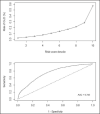Predicting the Onset of Opioid Use Disorder in the Swedish General Population
- PMID: 35590173
- PMCID: PMC9134993
- DOI: 10.15288/jsad.2022.83.332
Predicting the Onset of Opioid Use Disorder in the Swedish General Population
Abstract
Objective: Given the public health importance of opioid use disorder (OUD), we sought to understand better its risk predictors in the Swedish general population.
Method: We examined the Swedish population, born 1950-1970 (n = 2,092,359), and followed through 2018. Using Cox, logistic, and co-sibling models, we explored associations between a wide range of putative risk factors and a first onset of OUD--assessed through medical, criminal, and pharmacy registers--in the entire cohort and in the cohort wherein prior cases of drug use disorder (DUD) were censored.
Results: OUD was predicted by the following four risk factor domains: (a) externalizing syndromes, especially prior non-opioid DUD; (b) psychopathology; (c) psychosocial factors, including social class and immigrant and marital status; and (d) serious injuries and pain diagnoses. When predicting OUD as the first form of DUD, the importance of pain diagnoses as a predictor increased. Co-sibling analyses suggested that the association of some of these risk factors with OUD onset was likely largely causal, whereas others were a mixture of causal effects and familial confounding. An aggregate risk score from these individual risk factors had reasonable receiver operating characteristic (ROC) curve performance.
Conclusions: OUD is a multifactorial syndrome for which risk can be meaningfully predicted by prior externalizing syndromes, internalizing and psychotic psychopathology, indicators of psychosocial status, and predictors of pain diagnoses. Some important differences were seen in the prediction of any OUD onset versus OUD onset as the first form of DUD. Much of the effect of these predictors appear, in co-sibling analyses, to likely reflect causal influences.
Figures


Similar articles
-
Risk factors for the development of opioid use disorder after first opioid prescription: a Swedish national study.Psychol Med. 2023 Oct;53(13):6223-6231. doi: 10.1017/S003329172200349X. Epub 2022 Nov 23. Psychol Med. 2023. PMID: 36415073 Free PMC article.
-
Discontinuation and tapering of prescribed opioids and risk of overdose among people on long-term opioid therapy for pain with and without opioid use disorder in British Columbia, Canada: A retrospective cohort study.PLoS Med. 2022 Dec 1;19(12):e1004123. doi: 10.1371/journal.pmed.1004123. eCollection 2022 Dec. PLoS Med. 2022. PMID: 36454732 Free PMC article.
-
Trends in prior receipt of prescription opioid or adjuvant analgesics among patients with incident opioid use disorder or opioid-related overdose from 2006 to 2016.Drug Alcohol Depend. 2019 Nov 1;204:107600. doi: 10.1016/j.drugalcdep.2019.107600. Epub 2019 Sep 27. Drug Alcohol Depend. 2019. PMID: 31586806 Free PMC article.
-
The phenomics and genetics of addictive and affective comorbidity in opioid use disorder.Drug Alcohol Depend. 2021 Apr 1;221:108602. doi: 10.1016/j.drugalcdep.2021.108602. Epub 2021 Feb 22. Drug Alcohol Depend. 2021. PMID: 33652377 Free PMC article. Review.
-
Opioid withdrawal symptoms, a consequence of chronic opioid use and opioid use disorder: Current understanding and approaches to management.J Clin Pharm Ther. 2020 Oct;45(5):892-903. doi: 10.1111/jcpt.13114. Epub 2020 Jan 27. J Clin Pharm Ther. 2020. PMID: 31986228 Review.
References
-
- Blanco C., Wall M. M., Liu S.-M., Olfson M. Toward a comprehensive developmental model of prescription opioid use disorder. Journal of Clinical Psychiatry. 2019;81:19m12775. doi:10.4088/JCP.19m12775. - PubMed
-
- Blanco C., Wall M. M., Okuda M., Wang S., Iza M., Olfson M. Pain as a predictor of opioid use disorder in a nationally representative sample. American Journal of Psychiatry. 2016;173:1189–1195. doi:10.1176/appi.ajp.2016.15091179. - PubMed
Publication types
MeSH terms
Substances
Grants and funding
LinkOut - more resources
Full Text Sources
Medical

